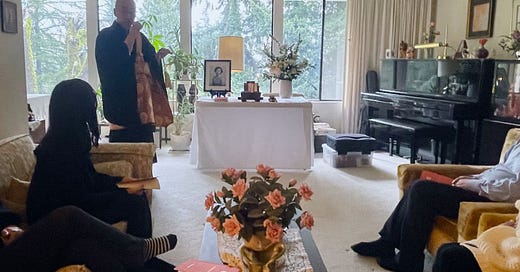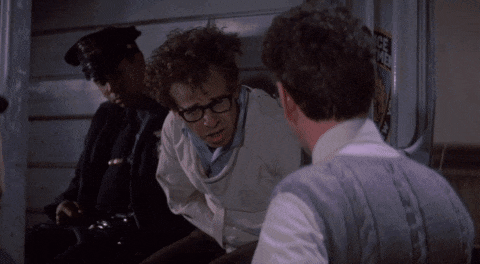“What is the role of Buddhism in modern life? Because even with all our technology, we still can't find the meaning of life on Google."
I appreciate the 2,600 year history of Buddhism and its role in helping us navigate the basics of life. Last year in 2024, Marsha and I faced the passing of a number of loved ones, and we understand that death is part of life. We were reminded through Buddhism of key messages, rituals, and traditions that have a rich history of providing closure to the living. As I look beyond death, I am still exploring beyond where Buddhism provides clear answers.
Those who passed are still with us
“In Buddhism, death is just a change of address. In other religions, it’s more like a permanent vacation.”
This past week marked the 1-year anniversary of the passing of Marsha’s mom. Consistent with the Japanese tradition, the ceremony was led by a Buddhist reverend in Marsha’s family home. While many of these 1-year ceremonies in the US happen at a temple, the Seattle Betsuin Temple is closed due to a fire last year, bringing many of the local ceremonies back to family homes, just as they were traditionally done in Japan. Having experienced the 1-year ceremony for the passing of Marsha’s dad in the temple almost 23 years ago, I felt the setting at home was even more apropos for reinforcing the lessons of Buddha. The basic message was that Marsha’s mom is still with us.
In Buddhist tradition, death is a part of life, and that the soul simply transitions into a non-human form where it can still guide those of us who are living.
The reverend asserted that, in this home, we could still feel the presence of Marsha’s mom. I don’t believe he was arguing that the presence of Marsha’s mom would light up the PKE meter (psychokinetic energy) from Ghostbusters, but I understood the assertion at a different level.
Instead, so much of what influences Marsha (and her brother) even today is symbolized by the history and artifacts in the home. I believe everyone present in that setting could feel Marsha’s mom and understand the message.
The value in the rituals
"Chanting in a group is like a spiritual karaoke session, but with fewer pop songs and more enlightenment."
This 1-year ceremony involved some traditional rituals. The reverend led the Buddhist chants and prayers, and we followed the tradition of offering incense.
For those of us in attendance, these rituals aren’t daily events. We didn’t regularly practice Buddhist rituals growing up, even though we had exposure to them on occasion when visiting relatives or commemorating ancestors.
Still, even without the corresponding religiosity, I personally find the repetitive nature of the chants does help to focus the mind, and the offering of the incense does provide something to “do” as a gesture of respect for the deceased.
Even more significant to me was the less formal discussion around what these rituals represent. There are dual messages reinforced by the rituals. Part of the messaging was really about supporting the journey of the deceased’s soul as it transitions to be reborn. Another part of the messaging was about the familial aspects of honoring ancestors. Both messages, I believe, help the living find closure, as well as a way to keep honoring the deceased. The messaging resonated particularly well with Marsha’s cousin, whose mom passed shortly before Marsha’s mom.
Tradition, not religion
"Religion is like a software update. When it’s time to upgrade, it absorbs the best features of the old version and adds some new ones."
In a little Q&A discussion as part of the ceremony, the reverend provided some (unintentionally) funny commentary about the origin of subsequent ceremonies at years 3, 7, 13, 17, 25, 33, and 50 years. The origin of these seemingly arbitrary intervals is more rooted in history than religion, as Buddhism (which originated in India) spread through China and later through Japan. When spreading through China, the death ceremonies of Confucianism were absorbed into Chinese Buddhism. The timing of the some of the ceremonies corresponded to 12 year intervals to correspond with the Chinese zodiac, but appear at years 13 and 25 after death because of East Asian age reckoning, where infants are 1 years old when they are born and age is counted by the years lived, rather than the days elapsed since birth. Then, apparently some decisions by emperors also changed the intervals. So, we are where we are with a seemingly arbitrary celebration schedule, with no real religious reason but rather the honoring of historical traditions.
And, the reason that these ceremonies typically stop at 50 is that generally after that period of time, no one is alive to remember the specific person anymore, so all the ancestors tend to be celebrated at once instead. As such, the Japanese celebrate Obon, which is a unified celebration of all ancestors. This all has a logic to it.
Lessons for modern life?
"Buddha taught us to live in the moment, but he never had to deal with a calendar full of Zoom meetings."
As I reflect on this, Buddhism understands that death is a part of everyone’s life and that it takes time and a process for people to get through it. There are a set of stories that must be told again and again. To this end, I see a value in these types of rituals to help us get through what we know to be hard experiences.
As I look at modern life, I think struggles like juggling the 5 balls of life (or even any of my reflections) are also part of everyone’s life nowadays. I don’t think there are well-known rituals to get us all through these hard experiences. We can look to the teachings of Buddha for universal issues like death that arose in life 2,600 years ago and persist. While the broader concepts of Buddhism remain true, how can the teachings be updated to resonate more easily in modern life?
These thoughts are what I want to continue to explore!






